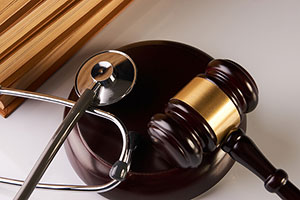A company called Acantha sued DePuy Synthes Sales and DePuy Synthes Products for patent infringement. Acantha patented an “Orthopedic Implant Assembly” for joining bone segments together during spinal surgery. The implant consists of a plate that is screwed into a bone segment. Once the head of the screw passes through an elastic snap ring, the snap ring returns to its original shape, holding the screw in place.
Acantha claimed that certain products made and sold by DePuy infringed on its patent. Like Acantha’s product, DePuy’s products had a “securing element” (a plate), an “attachment element” (a screw), and a “stopping member” that returns to its original configuration after the attachment element is inserted (as does Acantha’s snap ring).
Acantha argued that two DePuy product lines were infringing. The Vectra line, like the Acantha patented device, screws into a bone segment. The Zero-P VA line, however, screws into the disc space between vertebrae.
Acantha proved its claim to the satisfaction of a jury as to both DePuy product lines and won a judgment of more than $8 million. DePuy then moved the District Court for judgment in its favor as a matter of law.
The question before the court was whether DePuy’s product was the same as Acantha’s. DePuy argued that Acantha’s “securing element” was described as having an “anterior” and “posterior” surface and thus differed from DePuy’s product, which lacked those surfaces. To an ordinary person, most three-dimensional objects can be described as having a front and back or top and bottom, but DePuy argued that the terms had specific meanings that differentiated the two companies’ plates.
Expert Testimony
Acantha relied on the expert testimony of Dr. Sachs, who explained that the anterior surface of the plate was the surface closest to the surgeon — the surface where the screw enters the hole — while the posterior surface was the surface closest to the bone — the surface nearest the place where the screw will exit the hole and enter the bone. A layperson might think of those terms as meaning “top” and “bottom.”
DePuy argued that Dr. Sachs’ construction of the terms, by referencing the sides of the plate where the screw entered and exited the plate, improperly deviated from the court’s claim construction order. Before the trial, the court decided that the “term posterior should be understood to mean an inner portion of the assembly closer to the bone to which the assembly is attached, and the term anterior should be understood to mean an outer portion of the assembly farther away from the bone.”
Court’s Analysis of Zero-P VA Infringement
As to the Zero-P VA infringement claim, the court agreed with DePuy. The court decided that Dr. Sachs based his opinion on an incorrect understanding of the terms “posterior” and “anterior” as the court defined them.
The court noted that an expert can offer an opinion as to how the facts should be applied to an infringement claim, but that an expert must do so in a manner that is consistent with the court’s claim construction order. According to the court, the Zero-P VA could only infringe on Acantha’s product “if it has an anterior surface that is farther from the bone and a posterior surface that is closer to the bone to which it is attached.”
The Zero-P VA is placed between two vertebrae, and the two surfaces are therefore the same distance from the bone. Dr. Sachs’ testimony that the surface of the Zero-P VA where the screw enters is the “anterior” and the surface where the screw exits is “posterior” differed from the court’s determination of what those terms mean. The court accordingly disregarded Dr. Sachs’ testimony.
As defined by the court, the nature of the Zero-P VA plate differed from the plate described in Acantha’s patent. In the absence of Dr. Sachs’ erroneous testimony, the court decided that no reasonable jury could find DePuy’s patent infringed on Acantha’s. Of course, it may be that Dr. Sachs was right and that the court was wrong in defining the terms, but it is the court’s understanding that controls.
The court’s decision turns on a hypertechnical analysis of the language used in the patent description, but hypertechnical dissection of language is what lawyers and judges do. Perhaps if the lawyers who wrote Acantha’s patent description had expressly defined “anterior” and “posterior” in relation to where the screw entered and exited, the court would have accepted Dr. Sachs’ testimony and allowed the verdict to stand.
Court’s Analysis of Vectra Infringement
The court came to a different conclusion as to the Vectra line, which apparently mimics the Acantha device in all respects. DePuy attempted to identify a nonexistent difference by referring to the entire screw as a “screw head,” but the jury was entitled to rely on Dr. Sachs’ testimony that the spherical shaped, widest part of the screw is the screw head. Since he based that opinion on DePuy’s own documents, the testimony had a factual basis and the jury was entitled to accept it.
The jury was also entitled to reject the testimony of DePuy’s expert that screw threads are part of the screw head. Apart from the fact that the testimony is contrary to an everyday understanding that the head and threads are distinct parts of a screw, it was up to the jury to decide which of the two experts to believe.
Court’s Order
The court reduced the jury’s award of damages to about $4.3 million to account for its decision that DePuy’s Vectra line, but not its Zero-P VA line, infringed Acantha’s patent. Expert testimony therefore contributed to a sizeable verdict, although it did not support the entire verdict that the jury returned.




